Get started with the Linux terminal & begin using terminal commands
Objective
Background
90% of public cloud computing services run Linux. A competent software developer must know how to use a Linux system comfortably.
When you create your own Linux virtual machine (VM) from services like GCloud, AWS or Microsoft Azure, you don’t usually get access to a Graphical User Interface (GUI). You have to use the Linux terminal to operate and manage your VM.
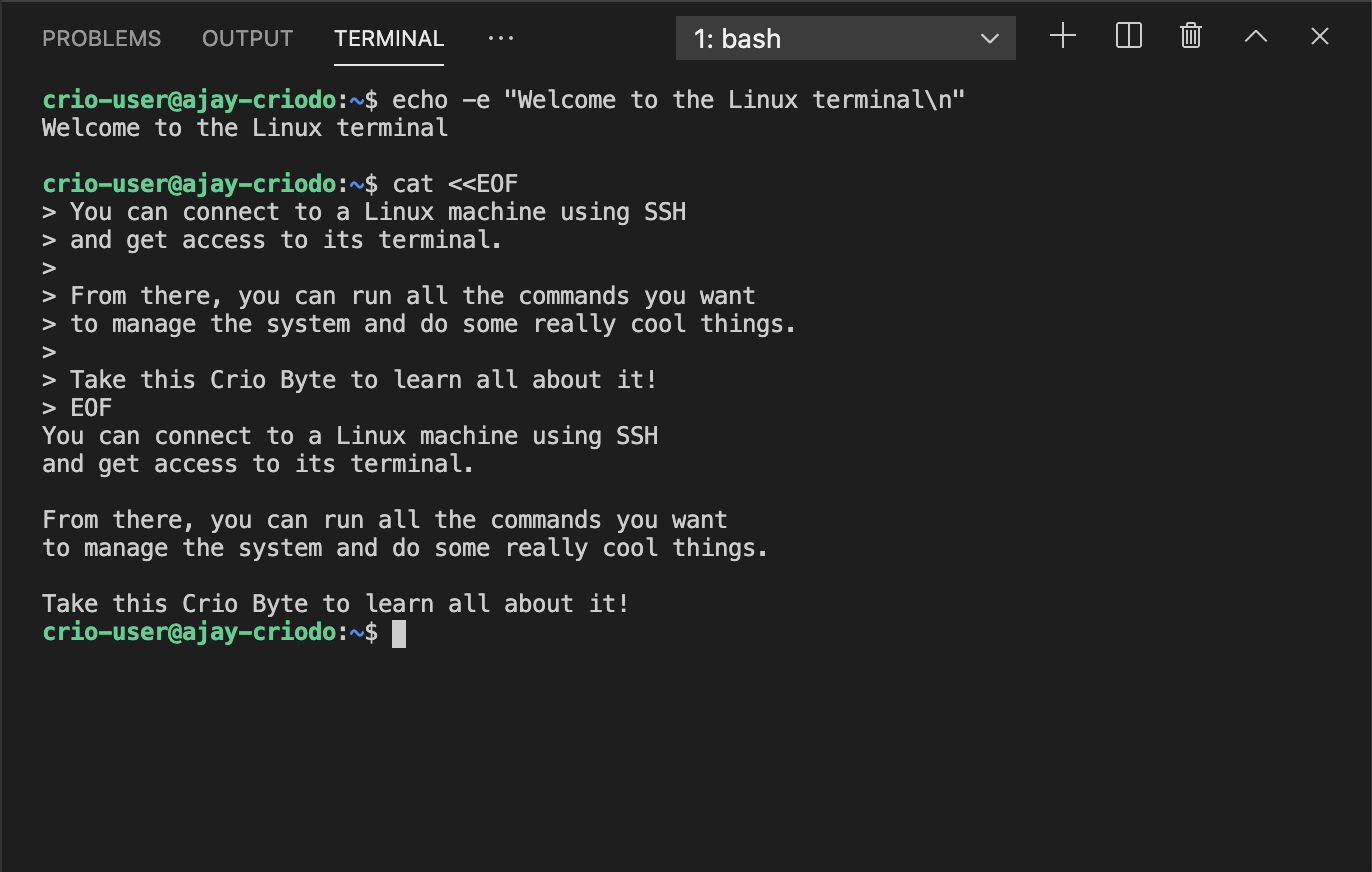
The Linux terminal
Some of the advantages of the Linux terminal include:
-
The ability to create and run scripts in several languages (Bash, Python, Perl, and more) right from the command line.
-
Easily automate several workflows that are much harder to do in a GUI.
-
The network bandwidth required to access a Linux system via terminal is far lesser than that required by a GUI.
-
You can look like a hacker :P
In this Crio Byte, you will familiarize yourself with the Linux terminal starting with some simple commands and proceed to learn commonly used developer workflows.
Primary goals
Here are a list of things you will learn in this Crio Byte:
-
Get familiar with the Linux terminal.
-
Learn the commands necessary to navigate directories and files.
-
Perform file management operations - create, read, update and delete.
-
Search directories for files and search files for interesting patterns.
-
Learn output redirection where you send the output of a command to a file (or as the input to a different command)
-
Performing Data Analysis of Hadoop log files right from the terminal and realize the power of Linux.

References
Objective
Get started with the Linux terminal & begin using terminal commands
Background
90% of public cloud computing services run Linux. A competent software developer must know how to use a Linux system comfortably.
When you create your own Linux virtual machine (VM) from services like GCloud, AWS or Microsoft Azure, you don’t usually get access to a Graphical User Interface (GUI). You have to use the Linux terminal to operate and manage your VM.

The Linux terminal
Some of the advantages of the Linux terminal include:
-
The ability to create and run scripts in several languages (Bash, Python, Perl, and more) right from the command line.
-
Easily automate several workflows that are much harder to do in a GUI.
-
The network bandwidth required to access a Linux system via terminal is far lesser than that required by a GUI.
-
You can look like a hacker :P
In this Crio Byte, you will familiarize yourself with the Linux terminal starting with some simple commands and proceed to learn commonly used developer workflows.
Primary goals
Here are a list of things you will learn in this Crio Byte:
-
Get familiar with the Linux terminal.
-
Learn the commands necessary to navigate directories and files.
-
Perform file management operations - create, read, update and delete.
-
Search directories for files and search files for interesting patterns.
-
Learn output redirection where you send the output of a command to a file (or as the input to a different command)
-
Performing Data Analysis of Hadoop log files right from the terminal and realize the power of Linux.

References
Open a Linux terminal
Note
If you are taking this Byte on your personal Linux machine or Gitpod, open a new terminal and proceed to the next milestone. You may skip the rest of this milestone.
Instructions for the Crio Workspace
To open a terminal in the Crio Workspace, follow the steps below:
-
Click on the workspace icon on the left sidebar and click on the
Startbutton to create your workspace. -
Once your workspace is ready, click on
Launch online IDE. -
Click on
View > Open in New Taboption (see image below).

- Open a new terminal, click on the
Menu > View > Terminal. (Note: The menu button is on the top-left (three horizontal bars).

What info does the GUI give us?
Let us see how the functionality provided by the GUI can be performed using the terminal.
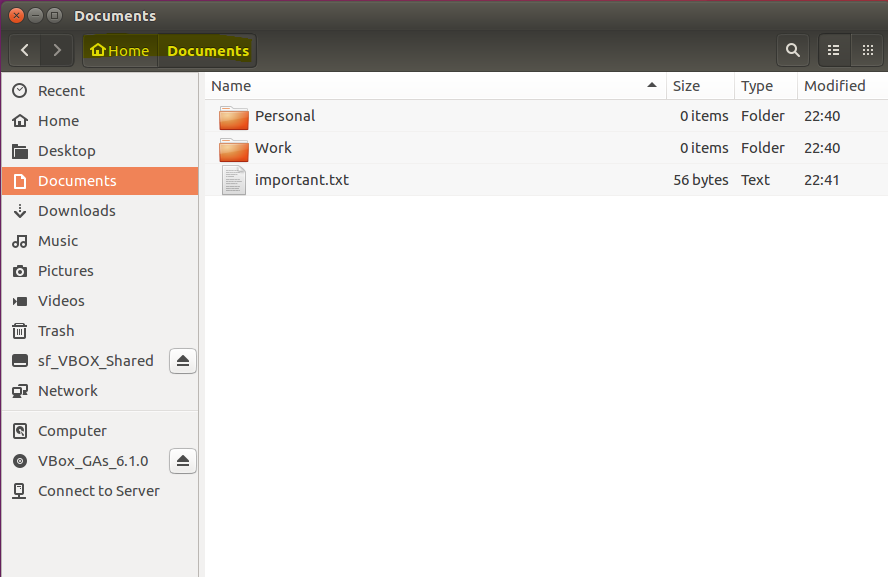
The Linux file explorer as seen in the GUI
Can you examine the screenshot of a file explorer window above and answer the following questions?
-
What is the name of the current working directory (a.k.a. present working directory)?
-
Which is the immediate parent directory?
-
Can you list the names of files and sub-directories in the present working directory?
-
Which file has the largest size?
-
Which file was modified most recently?
Pretty simple, right? Here are the answers for your reference:
-
The present working directory is
Documents. -
The immediate parent directory is the users
Homedirectory (Note:Homeis a special directory. We will learn more about this later). -
There is one file:
important.txtand two sub-directories:PersonalandWork. -
important.txthas the largest size (the others have size = 0 bytes since they are directories). -
PersonalandWorkhave the same last modified time, however,important.txtappears to have been modified most recently.
How do you get the above info using the Linux terminal? Below are a few commands to get you started.
Note
What you see on your machine/Gitpod might be slightly different from the screenshots here. So, for the rest of the Micro Experience, make sure that the commands work correctly relative to your directory structure.
1. pwd
You can use the pwd command to print the working directory..

The present working directory is /home/crio-user. Each linux user gets their own home directory. All user home directories are in /home. The username here is crio-user and hence the "Home" directory of crio-user is /home/crio-user.
Note
In Linux, directories are separated by the forward slash / (see the ? key on your keyboard). This is different from Windows where the backslash \ is used to separate directories.
2. ls
To list the contents of a directory, you use the ls command (short for list). When you run the ls command without any arguments, it lists the contents of the present working directory by default.

The output of the ls command is formatted differently based on the file type.

In the above example,
-
Directories are in blue
-
Files are in white
-
Executables are in green (we will learn more about executable files later)
Did you notice in the previous screenshot that the present working directory is different from the earlier example? How did we go from /home/crio-user to /home/crio-user/workspace/ajay-criodo-ME_QMONEY?
3. cd
You can change to a different directory using the cd command (short for change directory).
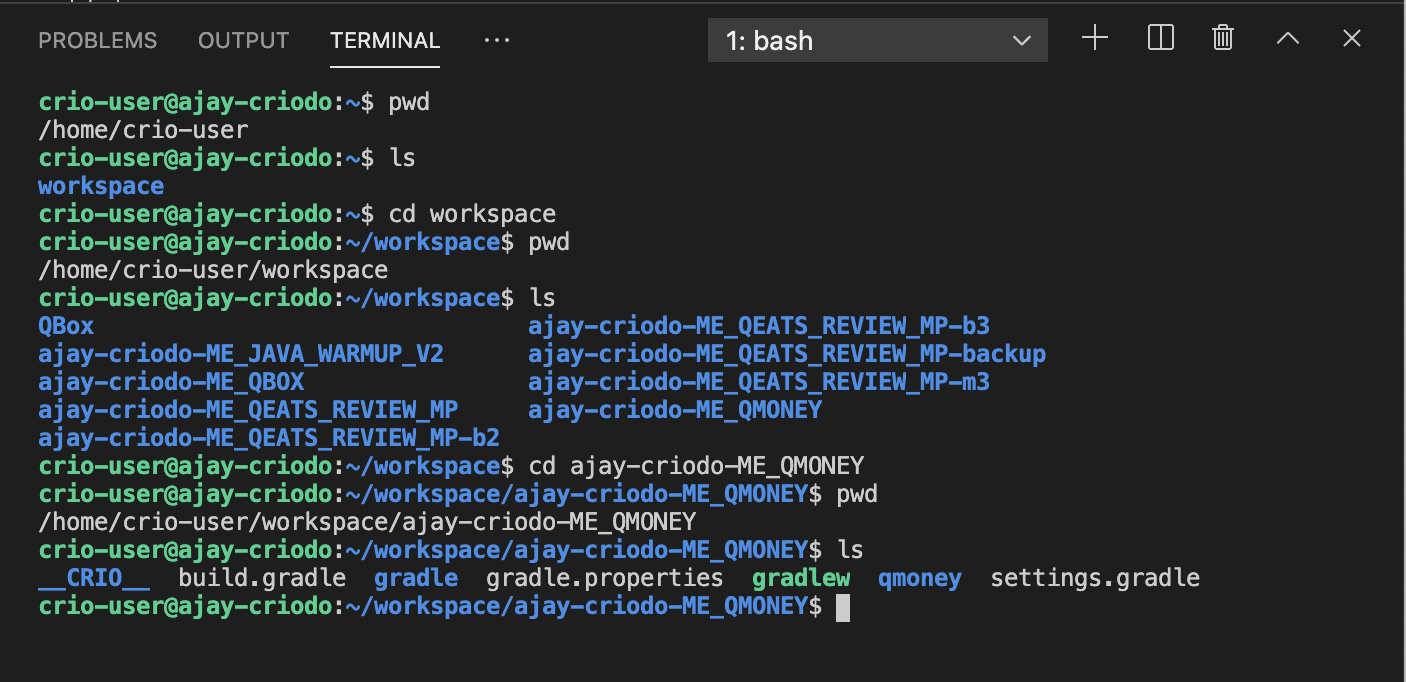
Did you notice the difference between the cd command and the pwd and ls commands you used earlier?
The examples shown in the screenshot pass an argument to the cd command. In this case, the destination directory was passed as the argument.
The destination directory can include a full path or a relative path (see the screenshot below for an illustration). This is true of the ls command as well.

Note
The pound sign # is used to write comments. Everything after the first # is ignored. Did you notice the comments in the screenshot above?
Default arguments
-
What if you execute the
cdcommand without any destination? Can you try it and see where it takes you? (Hint: Usepwdto check where you were taken to) -
Can you try the
lscommand with a directory name? -
Experiment with the
cdandlscommands with different arguments.
Note
-
If you don’t provide any argument to the
cdcommand, it defaults to the user’s home directory. Thelscommand defaults to the present working directory. -
There is a symbol to denote a user’s home directory. The tilde (
~) sign. -
cd ~will take you to your home directory. -
ls ~will list the contents of your home directory.
The Linux Directory Structure
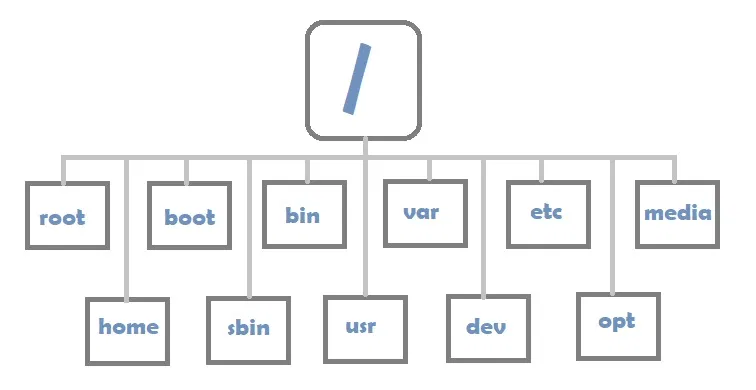
Let us take a moment to understand the naming convention above.

TODO - List the contents of the /var directory using the ls command learned in the previous milestone
Absolute path
In the Linux terminal, there is always more than one way to do the same thing. Below are some options to display the contents of /var.

Using the absolute path to access directories
Irrespective of the present working directory, you can run cd /var to take you to /var. Similarly, ls /var can be executed from any working directory and it will always display the contents of /var.
This is called using the absolute path where we provided the full path to a directory right from the root of the filesystem: /.
Relative Path
Relative paths are relative to the present working directory. A list of special relative paths are listed in the table below and additional examples are in the code block that follow.
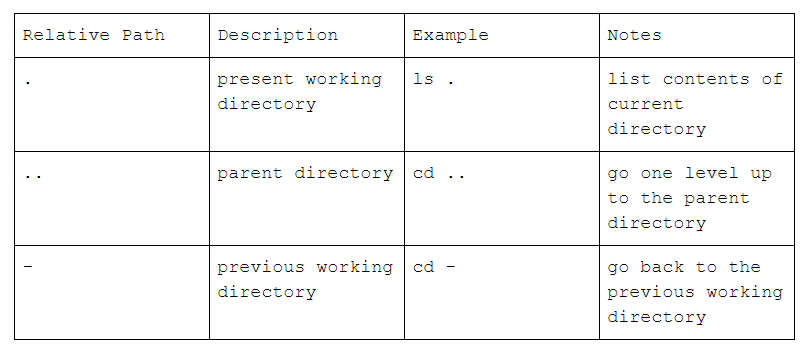
Additional examples
- Using relative path to go back to the parent directory
crio-user@ajay-criodo:~$ pwd
/home/crio-user
crio-user@ajay-criodo:~$ ls . ## list contents of the present working dir
workspace
crio-user@ajay-criodo:~$ cd ./workspace ## path is relative to the present working dir
crio-user@ajay-criodo:~/workspace$ pwd
/home/crio-user/workspace
crio-user@ajay-criodo:~/workspace$ cd .. ## one level up to the parent dir
crio-user@ajay-criodo:~$ pwd
/home/crio-user
- Easily go back to the previous working directory
crio-user@ajay-criodo:~$ cd workspace/ajay-criodo-ME_QMONEY/
crio-user@ajay-criodo:~/workspace/ajay-criodo-ME_QMONEY$ cd ../.. ## two levels up
crio-user@ajay-criodo:~$ pwd
/home/crio-user
crio-user@ajay-criodo:~$ cd - ## go back to the previous dir you came from
/home/crio-user/workspace/ajay-criodo-ME_QMONEY
crio-user@ajay-criodo:~/workspace/ajay-criodo-ME_QMONEY$ cd - ## and back again
/home/crio-user
- Using path relative to the home directory
crio-user@ajay-criodo:~$ cd ~/workspace ## path relative to the home dir
crio-user@ajay-criodo:~/workspace$ pwd
/home/crio-user/workspace
crio-user@ajay-criodo:~/workspace$ cd ../workspace/../workspace/../workspace ## fun :)
crio-user@ajay-criodo:~/workspace$
Try ls ~/workspace in the Linux terminal
Now, file explorer was giving us more info like the file size & modification time etc. How do we do that with ls?
Linux commands can be tuned to our requirements by providing flags along with the command when calling them. These are usually a hyphen (-) followed by an alphabet eg: -a, -B etc or double-hyphen (--) followed by text eg: --all, --color
But, how will we find a flag for our purpose?
Commands come with a "Manual" as well. We can access it using the man command followed by the name of the command we need to see the manual of. For ls, we do man ls.

-
NAME - name of the command & short description of what it does
-
SYNPOSIS - how the command is used
-
DESCRIPTION - detailed info on the usage of the command
We can see flags supported by the ls command listed out. You’ll be able to scroll through the manual. See if you can find the -l flag.

Ok, seems like something related to our need for finding more info about the directory content. Let’s try it. (Stuck inside the manual page? - Hit q to exit)
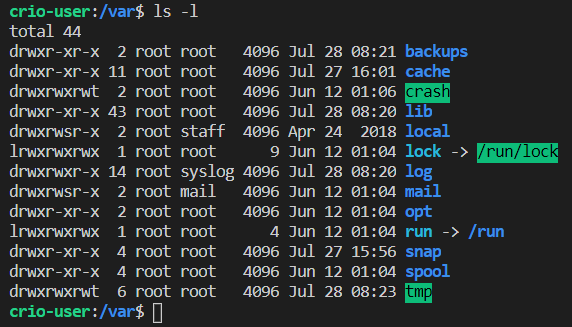
Gotcha!
The size of the file/directory in bytes is in the 5th column & 6th column is the last modified date & time. There’s a file lock -> /run/lock. Weird name, right? It’s a symbolic link i.e, /var/lock is actually pointing to the file /run/lock
Manipulating file permissions
Curious Cats
-
Find a command that prints out all sub-directories and files recursively
-
Try to remove the write permission for the
run.shfile. Will you be able to edit the file after this? -
chmodchanges the access mode for a file. Can you find out how we can change the owner of a file? -
ls -llists the contents in long form whereasls -tsorts the files according to their modification time. What if we need to do both?
Answers to these Curious Cats questions will be available in the Takeaways milestone at the end.
Navigating via the terminal
We’re inside our home directory (which is /home/crio-user for me). How will you go to the parent directory, ie /home?
We need to do cd /home, right?
What if we were inside /home/crio-user/Downloads/videos/series/english/got/season100/episode1 and we need to go back to the season100 folder? It’ll be quite tedious to type it out. Instead we can use cd .. for that. Double periods (..) is Linux lingo stands for parent directory. Try it out!
Cool! Are there any other shortcuts like these? Glad you asked :)
As you would’ve felt by now, the home directory of a user is an important directory and hence gets a shortcut. cd ~ will get you to the home directory of the current user no matter where you are inside the Linux filesystem.
Remember how we ran the run.sh file earlier? We did ./run.sh, right?
Similar to ".." denoting the parent directory, single period (.) denotes the current directory. Essentially, the earlier command was telling the terminal “Run this file present in the current directory”
CRUD - Create, Read, Update, Delete
We’ve been going back and forth between directories & listing out already available files. Let’s take it up a notch & create files of our own!
Come back to your home directory if you were lost trying out variants of cd from the previous section. Verify using pwd as always.
I watched K.G.F: Chapter 1 last night and I’m planning to store all movies I watch and some info about those, like synopsis, review etc. To start with, let’s create a directory structure like this in the home directory
/home/crio-user
|- kgf
|- cast.txt
|- part1
\- synopsis.txt
|- part2
\- synopsis.txt
Hmm, first we’ll create the directories required & then the files. mkdir is the command we need to make directories in Linux and we feed it the name of the new directory we want to create. So, we’d use mkdir kgf to create a directory called kgf. As we were in the home directory, the absolute path of the folder will be /home/crio-user/kgf (we could also do mkdir /home/crio-user/kgf). We’ll create the subdirectories using the mkdir command as well. Instead of using cd to go to the kgf directory and then using mkdir part1 we can use relative path to create the new directory from the home directory itself i.e., both the below sets of commands do the same thing.
cd kgf
mkdir part1
mkdir part2
Or
mkdir kgf/part1
mkdir kgf/part2
Cool. Now, we need to add files. That’d be the touch command. Come back to the kgf directory using cd if you are somewhere else. Execute touch part1/synopsis.txt to create a file named synopsis.txt inside part1 directory.
Similarly, create a synopsis.txt file inside part2 directory as well.
I’ll add the synopsis for part1 as it’s already out. nano command lets us edit files and is one of the default editors on Ubuntu. There would be other editors as well. Using nano part1/synopsis.txt will open the file for us to edit. After adding the required text
-
Hit
Ctrl + x -
Enter y when asked if to save
-
Hit Enter as we don’t need to change the file name we’re writing to
To verify the data was indeed saved, we can use the cat command to print out contents of a file. Execute cat part1/synopsis.txt
We have one more file to create - cast.txt. Execute touch part1/cast.txt to create it. With that, we have created all the directories and files as planned. It’s always good to verify when we’re done with something. cd to the kgf directory & execute tree command to print out a layout of files & directories under it.
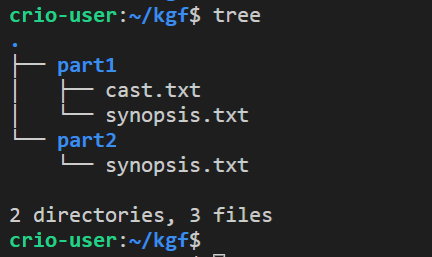
Oops! The cast.txt file should’ve been inside the kgf directory and not inside kgf/part1.
We can copy the file to the kgf directory and then remove part1/cast.txt. From the kgf directory, use
-
cp part1/cast.txt .- to copy the part1/cast.txt file to directory denoted by "." which we know from our earlier discussion is the current directory -
rm part1/cast.txt- to remove the part1/cast.txt file
Use the tree command now to verify the structure again
References
Curious Cats
-
To create the dir1/subdir1 directory, we can use
mkdir dir1,cdto dir1 and then executemkdir dir1/subdir1. Can you find out if it’s possible to create the dir1/subdir1 directories using a singlemkdircall? -
Does Linux provide some command to just move files from one directory to another rather than having us to do a copy first & then remove the original?
-
On second thoughts, we decide to remove the part2 directory. How would you delete a directory?
Answers to these Curious Cats questions will be available in the Takeaways milestone at the end.
Writing to files via output redirection
In milestone 2, we used the below command to create a file called run.sh & then looked at how to run it.
echo "echo 'Congratulations on running a bash script'" > run.sh
But, what was it actually doing?
echo command is used to print out the value provided to it. By default, it prints the value to the terminal which is the "standard output". Try running echo 'Congratulations on running a bash script'

Now, we want this command to be run when the run.sh file is executed (or run). For this, we need to add the whole command echo 'Congratulations on running a bash script' itself to the file. As we didn’t know about using the nano editor earlier (or echo for that matter :) ), we used the echo command itself to write the whole command to the file.
echo "echo 'Congratulations on running a bash script'" prints echo 'Congratulations on running a bash script' to the terminal. We can redirect the output instead to a file using the redirection operator >. You can verify this indeed was happening earlier by cating the content of the run.sh file from earlier to the terminal.
Feeding Output of a command to the Input of another
The /proc/meminfo file has info related to the RAM installed in our system. Try using cat to print its content. The first three lines are the attributes MemTotal, MemFree & MemAvailable. What if we needed to print out just the value of the MemFree attribute which denotes the amount of free memory?
We’ll be required to perform a couple of actions.
-
Filter for the line in /proc/meminfo containing the attribute MemFree
-
Fetch the numerical value in that line by separating that column
grep command is used to filter/search for text using strings or patterns. It’s usage is grep <pattern> <file>. For us, it’d be grep MemFree /proc/meminfo. You’ll see only the line containing MemFree from /proc/meminfo filtered out. Let’s write it to a file using the redirection operator (>) we learnt in the previous section.
(The MemFree value is dynamic & hence can be different every time we print it out)

Now, how will we fetch only the numerical value?
awk can do that for us. It uses space as a field separator (by default space is used as field separator but other field separators can be specified) and separates text into columns. That’d mean, we have 3 words in our line - MemFree:, 918648 & kB. To print out the 2nd word, the usage is awk '{print $2}' memFreeLine.txt where $2 denotes the second word in the line.
That did the work for us and we have just the free memory in kB printed out to the terminal. Looking back, the memFreeLine.txt file was a by-product which we didn’t actually need. Is there some way to do this without having to create this file?
Piping is a type of redirection in Linux used to send output of one command to input of another command. We had earlier written the output of grep to a file & then used it as input to awk. Instead of this, we can use the Linux pipe operator (|) to redirect output of grep directly to input of awk.

As you can see, awk command isn’t given a file to read from but rather get its input from out of grep because of the use of the pipe operator (|).
You can continue linking together more commands like this, using multiple pipes, to achieve any of your goals!
Like we saw here, there can be multiple ways we can do a task in Linux
References
Curious Cats
-
We came across a couple of ways to redirect the output of a command. > operator writes output of a command to a file. Try running
echo "Hello" > hello.txtcommand two times andcatcontent of hello.txt. Does it contain one Hello or two? How can we append data rather than overwrite it here when using redirection? -
The | operator sends output of a command as input to another. What if we needed to print the output of the first command to the terminal as well as redirect it to a file?
-
What if I need to see the first 20 lines of a file? Is there some command that lets us fetch some lines from the starting of the file?
-
What if you want to see contents of a file getting printed to screen as and when the file is being written to?
Answers to these Curious Cats questions will be available in the Takeaways milestone at the end.
Data analysis from the command line
With the Linux terminal power behind us, we’ll apply this to gather statistics/data from standard software logs. Don’t worry if you don’t understand all the commands in the script. This exercise is to just help you understand the power of Linux. You may have to take Linux Basics 2 to comprehend the entire script.
Hadoop log Analysis
-
Hadoop (https://hadoop.apache.org) is a big data processing framework that allows for the distributed processing of large data sets across clusters of computers using simple programming models.
-
We have a Hadoop log bundle here
-
And this is the data we want to pull up from the logs
-
How many log files do we have?
-
Number of "ERROR"s seen across all the logs
- Similarly, how many "FATAL", “WARN” and “INFO” messages do we see
-
How many "Exceptions" do we see?
-
Which of these exceptions are related to the disk being full?
-
Print out a list of log filenames and the count of how many exceptions are seen in each file, if the count is > 1
-
Print a Histogram of these counts per file
-
-
Filter out across the log files, all events that occured at a particular minute
-
E.g. "2015-10-19 14:25"
-
List all log file names where we can see log messages for this minute
-
-
How many "MapTask metrics system" and “ReduceTask metrics system” shutdowns were completed?
-
Let’s look at how this can be achieved easily with Linux commands.
Download the script and execute it using these commands
crio-user:~/workspace$ wget https://gitlab.crio.do/crio_bytes/me_linux1/-/raw/master/hadoop_log_analysis.sh -O hadoop_log_analysis.sh
crio-user:~/workspace$ chmod +x hadoop_log_analysis.sh
crio-user:~/workspace$ ./hadoop_log_analysis.sh /tmp/log_analysis
The script prints out all the data we need, as a report.
Take a detailed look at the commands in hadoop_log_analysis.sh and you’ll see how each task is achieved using a combination of simple commands.
Note: You can achieve the same with a Python script (or other alternatives) from the command line as well.
That's about Hadoop Analysis. Are you ready to analyse some more log files on your own?
Now you are given some log files and no script this time, Go through the log files and try to come up with a script similar to the one provided for Hadoop Analysis.
OpenSSH log Analysis
-
OpenSSH is the premier connectivity tool for remote login with the SSH protocol.
-
We have an OpenSSH log here
-
And this is the data we want to pull up from the logs:
-
How many break in attempts do we see? ("POSSIBLE BREAK-IN ATTEMPT!")
- Reference: Brute Force and Hail Mary attacks
-
How many invalid certificate attempts do we see?
- Are there particular IP addresses from which these invalid requests are coming in?
-
What are the ports that the OpenSSH server is listening on? (E.g. "Server listening on 0.0.0.0 port 902")
-
Plot the number of Error messages across time. This will show the time periods where errors were higher.
-
How many accepted connections do we see? (E.g. "Accepted password for curi from 137.189.90.232 port 20631 ssh2")
-
-
How would you go about achieving this from the Linux Terminal?
Apache log Analysis
-
Apache HTTP Server (https://httpd.apache.org) is one of the most popular web servers. Apache servers usually generate two types of logs: access logs and error logs.
-
We have an Apache error log here
-
Can you come up with interesting statistics for this log file and do the analysis?
References
Note
The commands in the following section might not work on Gitpod because of security issues. You’re welcome to try them out if you have a Linux machine, or can just read through the rest of the milestone.
Task Automation
Good developers don’t like to do the same tasks repeatedly. Scripts and/or automation is their answer to these repetitive tasks.
Let’s use the Hadoop log analysis script from the previous section and automate its execution.
If we need to run this script every 5 mins, given that new logs are being generated, let’s see how to achieve this. (In the real world, you may want to run it less frequently. For demonstration purposes, let’s run it every 5 mins).
Note: This script downloads the files from a static web link. On a live server, this script would fetch files from a directory on the Hadoop server(s) or run on the server itself.
We will use an in-built utility on Linux called cron to schedule execution of this script.
The Cron runs processes on your system at a scheduled time. Cron reads the crontab (cron tables) for predefined commands and scripts that need to be run.
By using a specific syntax, you can configure a cron job which schedules scripts or other commands to run automatically.
Run the below commands to set the cron job
# Open the cron tables with this command
crio-user:~/workspace$ crontab -e
# This will open the crontab file in an editor. Choose nano if prompted for choice of editor.
# Go the last line of this file and add the below line
5 * * * * /home/crio-user/workspace/hadoop_log_analysis.sh /tmp/log_analysis > /home/crio-user/workspace/log_report
# Substitute the above paths to suit your setup
# Save file and exit ("Ctrl X", followed by “Y”, followed by “Enter” to exit nano editor)
Reference links have been provided below to understand the crontab structure in detail.
This is what we’ve currently done
-
Specified that the the job should be run automatically, every
5minutes -
The job to be run is the
/home/crio-user/workspace/hadoop_log_analysis.shscript with/tmp/log_analysisas a command line parameter (this directory will be used to save log files). -
The output of the job (which is the log analysis report) gets stored in the file
/home/crio-user/workspace/log_report. Modify this path accordingly if you are not in the Crio Workspace.
Verify that the /home/crio-user/workspace/log_report is being created every 5 minutes.
Automation was easy!
The script can be enhanced to send a text message or an email when a particular value in the report is not as expected. For example, when too many FATAL messages are seen.
Other example tasks you could accomplish using cron jobs
-
Backup files or database periodically
-
Cleanup disk space when it fills up beyond a certain limit
-
Monitor processes and restart them if they go down
Useful shortcuts
-
up arrowkey → will bring up the last command that was executed. Each press will bring up the previous command executed. -
history→ will print out a list of the previous commands executed. -
tabkey → pressing the tab key can be used to auto-complete the directory and file names while typing paths or filenames.
References
-
Find pointers to Curious Cats questions here
-
Handy Linux cheat sheet - Cheat Sheet 1 and Cheat Sheet 2
-
Examples for Linux usage - Examples
-
Detailed Linux command list - Linux Programming Commands
Why Linux?
A majority of systems around the world run some form of Linux. These range from enterprise and desktop servers to smartphones.
-
60 to 70% of all Web Servers in the world run some form of Linux/Unix and ~90% of all cloud computing happens on Linux based servers.
-
Most of the smartphones in the world run on Linux.
-
Mac is based on Unix and supports a terminal where these commands can be run.
In the Real World
-
What does Linux power - 25 Awesome unexpected things powered by Linux
-
What you could use Linux additionally for - Alternative examples of Linux usage
Special update
Windows users don’t have to fret with having to have a virtual machine to run Linux anymore - we have a treat by Microsoft, called the Windows Subsystem for Linux, which lets us Windows folks use the CLI without any need to waste precious memory installing the gigantic VM and having your computer go into coma every time you boot. Check out more details - https://docs.microsoft.com/en-us/windows/wsl/about
Newfound Superpowers
-
Knowledge of an all powerful Linux terminal
-
Most commonly used Linux commands in your arsenal
Now you can
-
Explain where the terminal fits in & how it acts as an alternative to the GUI
-
Run commands in the terminal & modify their behaviour using flags
-
Navigate easily across directories and create/read/update/delete files & directories
-
Filter data stored in files and redirect output of commands to either a file or as input to another command


